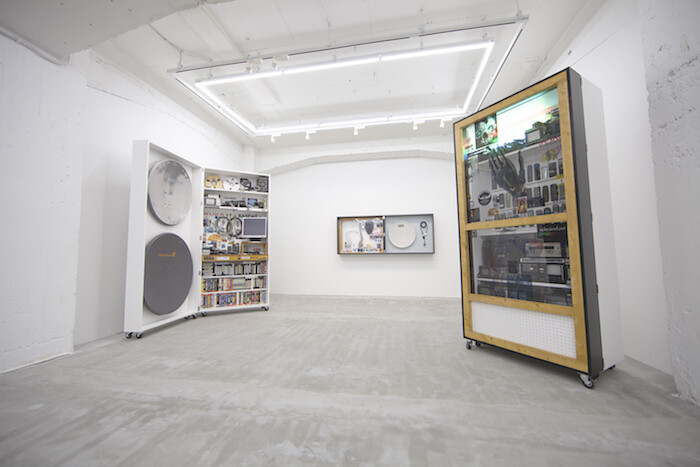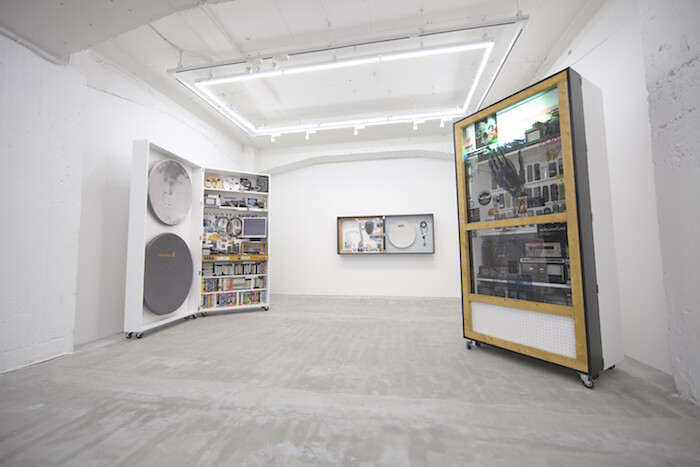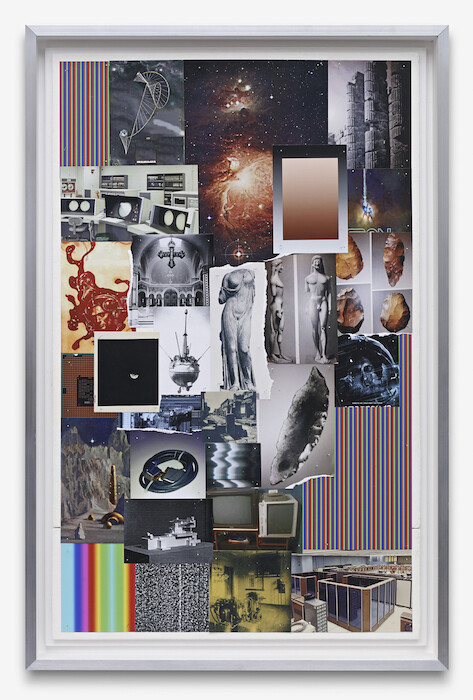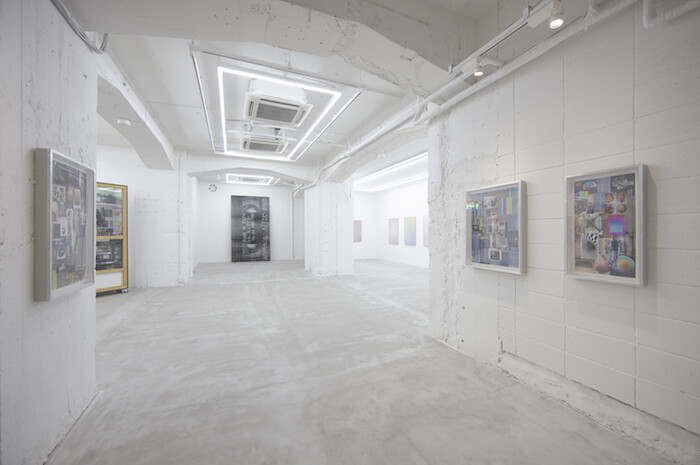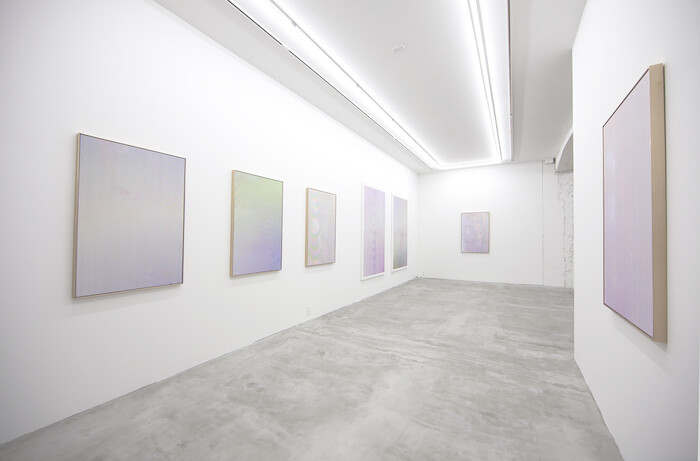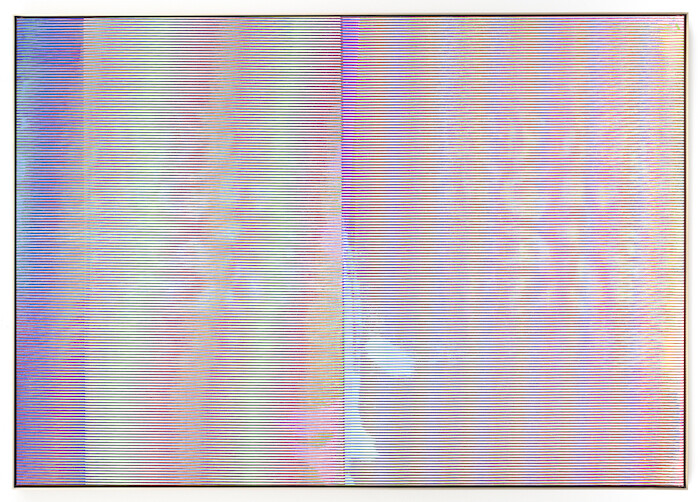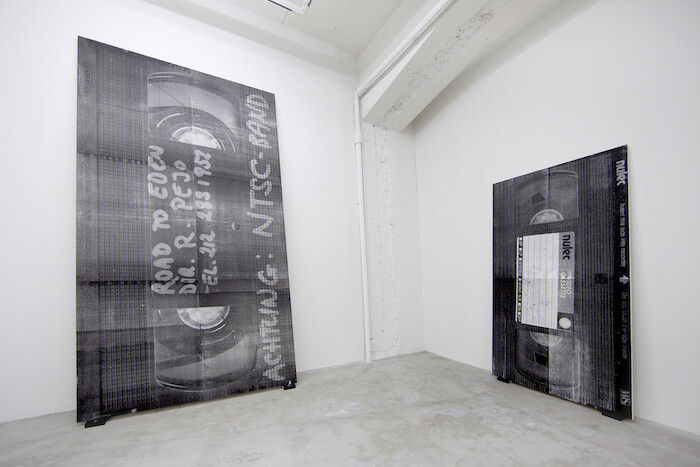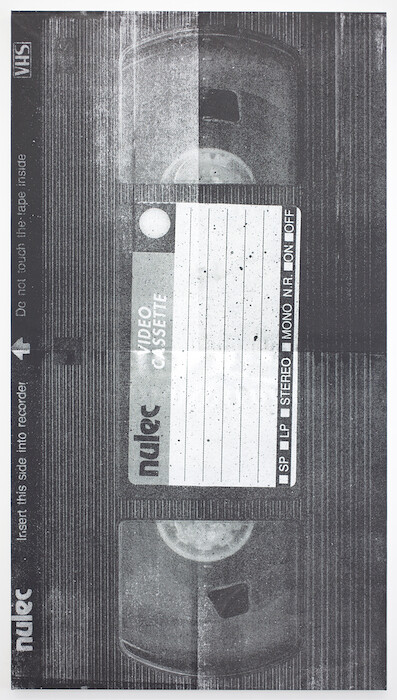It felt entirely appropriate to see “Time To Die”— Joep van Liefland’s first solo exhibition in Japan—on Halloween. As evening fell, the Blade Runner-esque streets around Nanzuka Gallery began to seethe with a human froth of staggering zombies, gibbering corpses, and wounded cosplay nurses. Despite their macabre costumes, the crowds of young people gathering in Shibuya were abuzz with youth and happiness; death never seemed more vital.
A similar paradox was at work in van Liefland’s show. In a hipsterish version of the Day of Judgment, dead video formats were resurrected and celebrated: cabinet installations displayed battered satellite dishes, coiled SCART cables, assorted ugly remote controls, and spools of outmoded ferrous tape. Mounted on pegboard were stickers for half-forgotten electronics brands, prosthetic limbs, bionic skulls, generic batteries, faded adverts for once-futuristic formats.
Beginning with the collage Untitled (Theology of technology 7) (2015)—a juxtaposition of images of color wheels, space tech, classical Greek statuary, and mineralogy—the exhibition led into what appeared to be a 1980s video repair shop, but on closer inspection turned out to be an assemblage of installations featuring remote controls in a light box. Here—thinking of the protests that greeted Omer Fast’s recent exhibition “August” at James Cohan Gallery1—I began to wonder if the show might be framing itself in terms of something like “the problematical renegotiation of abjection.” Without invoking the racial or gentrification issues that Fast did in New York’s Chinatown, van Liefland might still be congratulating himself for the freshness of a flea-market vision which allows him to isolate the potential in a pile of neglect and decay, and thereby drive up prices.
Or is “archeologist of the recent past” a better metaphor? Van Liefland seems to share the interest of a certain generation of artists (Mark Leckey, Jeremy Deller, Cory Arcangel) in the visionary and utopian promise that twentieth-century technologies and their attendant aesthetics brought, but also our twenty-first-century tendency to (in Leckey’s self-mocking phrase) “wallow in the mire of nostalgia”2—and particularly nostalgia for the better future the past seemed sure about. Ironically, the shudder of mingled attraction and repulsion we feel about the sublimated recent past has itself become part of a sublimated intellectual past—terms like retromania, hauntology, digital flesh, and the aesthetics of failure are apt to make us cringe, but the emotional voltage of that cringe continues to power a potential for their eventual redemption in the form of a return of the technological repressed (the renewed popularity of vinyl, for instance). Modernity continues to be our antiquity, even if that slogan itself now sounds old.
Elsewhere in Nanzuka’s vault-like basement space van Liefland has posed giant canvases of screen-printed VHS cassettes, wittily mounted on actual VHS cassettes (Untitled (Nulec), 2017), and hung a room of Op Art-like stripe paintings magnifying headache-inducing video glitches (RGB C-9010, 2017). I can’t help thinking of the trend, about a decade ago, for pop videos to imitate bandwidth-bottlenecking keyframe errors. It’s an association that troubles me.
Nanzuka is known for its graphic design sensibility, and van Liefland’s show certainly has the coherence—the strong recognition factor—of a graphic design project: his aesthetic is perhaps too clearly organized around the eldritch appeal of dead video tech, and his ironic-utopian techno-gothic sensibility (exemplified by the sci-fi goretrash titles of past works like Turbo Teenies Necroevolution meets Zombie 2) is overly familiar. As in graphic design—and the Japanese cosplay Halloween happening up at street level—the isotypes and memes are a little too repetitive, too immediately identifiable, too trendy, redemptive, and reassuring. The horror-bunnies and cyber-witches gathering in Shibuya have made death itself into something glib and pat, a familiar sign.
Rainer Maria Rilke said that “beauty is nothing but the beginning of terror which we are barely able to endure,”3 and that’s what art at its best can be too: a way to shock us into seeing things afresh, if only for a split second. If I say that this show felt more like good graphic design than good art, it’s because confronting the work felt more like recognition than cognition—more horror-as-genre than horror-as-emotion. Like the zombies emerging obediently through the Yamanote line ticket gates, van Liefland seemed to be coming from a place I knew.
Danielle Wu, “Artist Omer Fast’s Take on Chinatown Angers Community Organizations,” Hyperallergic (October 2017), https://hyperallergic.com/405024/artist-omer-fasts-take-on-chinatown-angers-community-organizations/.
Mark Leckey, “I Wallow in the Mire of Nostalgia,” Tate Shots (October 28, 2016), http://www.tate.org.uk/context-comment/video/mark-leckey-i-wallow-mire-nostalgia-tateshots.
Rainer Maria Rilke, “The First Elegy,” tr. Stephen Mitchell, 1923. Reprinted in Duino Elegies and The Sonnets to Orpheus (London: Vintage International, 2009), 3.
